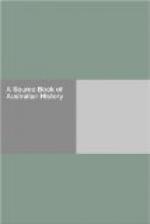Sunday, 22nd April. Small Gum Creek, under Mount Stuart, Centre of Australia. To-day I find from my observations of the sun, 111 deg. 00’ 30”, that I am now camped in the centre of Australia. I have marked a tree and planted the British Flag there. There is a high mount about two miles and a half to the N.N.E. I wish it had been in the centre; but on it to-morrow, I will raise a cone of stones, and plant the flag there, and name it “Central Mount Stuart.” We have been in search of permanent water to-day, but cannot find any. I hope from the top of Central Mount Stuart to find something good to the N.W. Examined a large creek; can find no surface water, but got some by scratching in the sand. It is a large creek divided into many channels, but they are all filled with sand; splendid grass all round this camp.
Monday, 23rd April. Centre. Took Kekwick and the flag, and went to the top of the Mount, but found it to be much higher and more difficult of ascent than I anticipated. After a deal of labour, slips and knocks, we at last arrived on the top. The view to the north is over a large plain of gums, mulga, and spinifex, with watercourses running through it. The large gum creek that we crossed winds round this hill in a N.E. direction; at about ten miles it is joined by another. After joining they take a course more north, and I lost sight of them in the far distant plain. To the N.N.E. is the termination of the hills; to the N.E., E. and S.E. are broken ranges, and to the N.N.W. the ranges on the west side of the plain terminate. To the N.W. are broken ranges; and to the W. is a very high peak, between which, and this place to the S.W. are a number of isolated hills. Built a large cone of stones, in the centre of which I placed a pole with the British flag nailed to it. Near the top of the cone I placed a small bottle, in which there is a slip of paper, with our signatures to it, stating by whom it was raised. We then gave three hearty cheers for the flag, the emblem of civil and religious liberty, and may it be a sign to the natives that the dawn of liberty, civilization, and Christianity is about to break upon them. We can see no water from the top. Descended, but did not reach the camp till after dark. This water still continues which makes me think there must certainly be more higher up. I have named the range “John Range,” after my friend and well-wisher, John Chambers, Esq., brother to James Chambers, Esq., one of the promoters of this expedition.
ACROSS AT LAST
Thursday, 24th July. Thring Creek, entering the Marsh. Started at 7.40, course north. I have taken this course in order to make the sea-coast, which I suppose to be distant about eight miles and a half, as soon as possible; by this I hope to avoid the marsh. I shall travel along the beach to the north of the Adelaide. I did not inform any of the party except Thring and Auld, that I was so near to the sea, as I wished to give them a surprise on reaching it. Proceeded through a light soil, slightly elevated with a little ironstone on the surface, the volcanic rock cropping out occasionally; also some flats of black alluvial soil. The timber much smaller and more like scrub, showing that we are nearing the sea.




